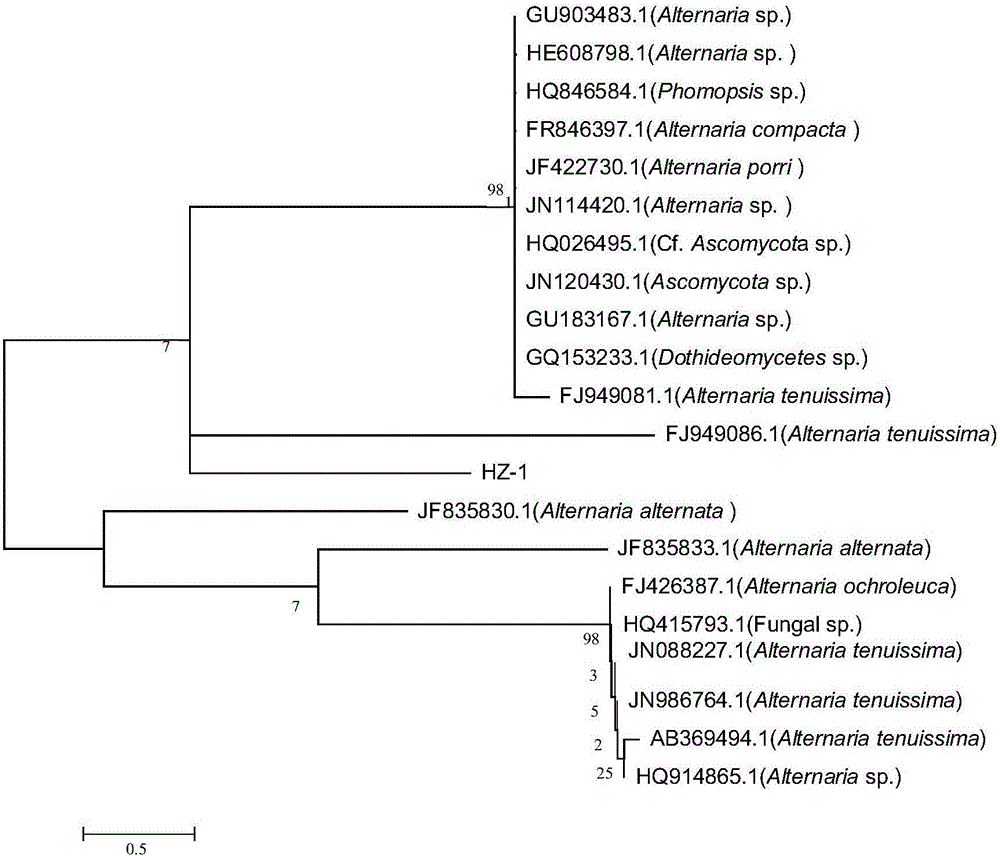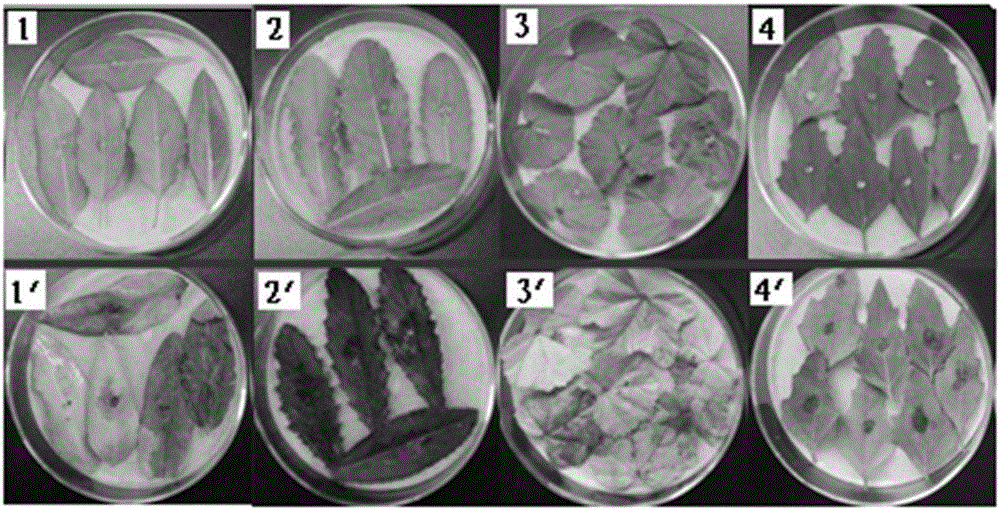Alterneria tenuissima and application thereof in biological weeding
A technology of Alternaria tennatus and strains, applied in the field of ecology, can solve the problems of aggravated pollution, reduced and enhanced drug efficacy, and achieve the effects of less environmental negative effects, low residual environment, and less impact on crops
- Summary
- Abstract
- Description
- Claims
- Application Information
AI Technical Summary
Problems solved by technology
Method used
Image
Examples
Embodiment 1
[0025] Example 1 Isolation and Identification of Bacteria
[0026] 1. Isolation and purification of bacteria
[0027] Referring to the isolation method of relevant pathogenic fungi in "Methods of Plant Disease Research" (edited by Fang Zhongda, China Agricultural Press, 2007.4), the diseased leaves of Geranium plants collected from Huzhu were separated and purified according to the tissue separation method, and after slant culture Store in refrigerator at 4°C. The isolated strain was named HZ-1 according to the place where it was collected.
[0028] 2. Identification
[0029] The strain HZ-1 was cultured on a PDA plate medium, and the colony growth rate, colony shape and color changes were observed regularly, and the mycelium and spore morphology were observed under an optical microscope. Combined with "Handbook of Fungal Identification" (edited by Wei Jingchao, Shanghai Science and Technology Press, 1979.9) for preliminary identification.
[0030] The morphology and physi...
Embodiment 2
[0040]Example 2 Effect of bacterial strain HZ-1 on the pathogenicity of broad-leaved weeds
[0041] Transplant quinoa, mallow, and Polygonum sorrel with normal leaf color at the 4-5 leaf stage in the field, and pig scallops at the 4-6 whorled leaf stage in flowerpots (Φ=15cm), and cultivate them in the laboratory. ; After the biocontrol fungus was expanded and cultivated for 120h in the PDB nutrient solution, 10 7 pcs mL -1 The fermented liquid was sprayed and inoculated on the transplanted healthy weed plants, and the inoculation amount was 30mL / pot. The plants inoculated with PDB culture solution were used as blank control; three repetitions were set. The inoculated weed plants were placed at room temperature, and the relative humidity was maintained at 60% with a JBX-3.5 centrifugal industrial humidifier, and the light and dark were alternately cultivated for 12 hours. After 7 days, the weed incidence degree was investigated, the fresh weight was weighed, and the inciden...
Embodiment 3
[0046] The impact of embodiment 3 strain HZ-1 on the safety of crops
[0047] Five main crops in Qinghai Province: spring wheat (Qingqing 587), spring rape (Qingza No. 5), broad bean (Qinghai No. 9), pea (Grassland 224), and highland barley (Beiqing No. 8) were planted in Φ=15cm In flowerpots, cultivated indoors for later use. After dilution of the HZ-1 fermentation broth, inoculate it on the crop plants at the 3-4 leaf stage according to the above method, set up 3 repetitions, observe the disease of the tested crops 7 days after inoculation, and record the degree of disease.
[0048] Such as Figure 5 As shown, the fermentation broth of HZ-1 strain had no pathogenicity to spring wheat (Qingqing 587), pea (Grassland 224), broad bean (Qinghai No. 9), and highland barley (Beiqing No. 8) after inoculation. Compared with the control plants, they were not affected, showing no reaction (NS); they were mildly pathogenic to spring rape (Qingza No. 5), and 3 days after inoculation, 5...
PUM
 Login to View More
Login to View More Abstract
Description
Claims
Application Information
 Login to View More
Login to View More - R&D
- Intellectual Property
- Life Sciences
- Materials
- Tech Scout
- Unparalleled Data Quality
- Higher Quality Content
- 60% Fewer Hallucinations
Browse by: Latest US Patents, China's latest patents, Technical Efficacy Thesaurus, Application Domain, Technology Topic, Popular Technical Reports.
© 2025 PatSnap. All rights reserved.Legal|Privacy policy|Modern Slavery Act Transparency Statement|Sitemap|About US| Contact US: help@patsnap.com



